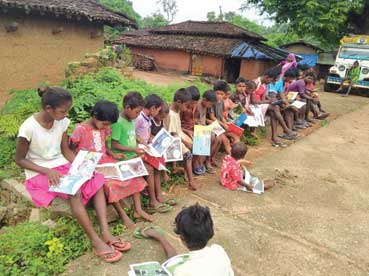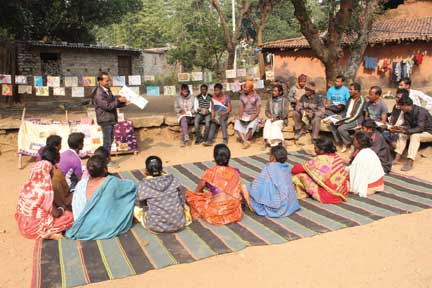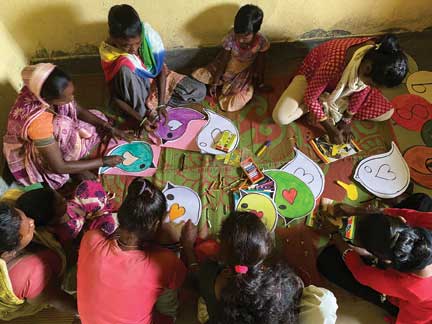Divya Jyoti Tirkey and Mamura Khan
A ‘jhola library’ sets out to the villages with a bag full of books. These are displayed at a common place in the village where everyone can have access to read the books. The “Jhola Libraries”, an initiative taken during the abrupt pandemic-induced school closure, has been instrumental in creating library spaces where all community members, children and others, irrespective of caste, class, gender or any other social disparity come together to read books.
Another initiative “Mini-Libraries” was implemented where a collection of books was displayed either in a School Management Committee (SMC) Member’s house or a volunteer’s house. Anyone in the village had access to these books. Both these concepts received an overwhelming response during the school closure last year.

Around 500 such initiatives were taken in the remote villages of Jharkhand where Collectives for Integrated Initiatives (CInI) www.cinicell.org implements its education programs in collaboration with the education department to ensure quality education to children belonging to tribal and other disadvantaged communities. More than 5000 children used these small libraries. These initiatives were taken to circumvent hindrances to children’s education in the light of the COVID-19 pandemic.
The visualization of such libraries and those like community libraries is contrary to how libraries were visualized historically. A library is traditionally visualized as a room or a building where a collection of books is kept, often guarded and locked away. These libraries were used only to gather information by those who were into reading, writing or researching. The access was exclusively to those who had the privilege of being a member of that library. These libraries were often located in cities. Over time, the visualization of libraries has changed and is further changing. Libraries are now visualized as spaces where more and more people and children visit, activities happen around and beyond books, all read for joy and everyone feels purposeful. A culture of inclusion begins to emerge in this practice. Thanks to all who advocate and work for such libraries!
Building a culture of inclusion through libraries was one among many objectives of the “Jhola” and “Mini” libraries. The books were made available at the door step of children and communities so that everyone had access to books; be it children, parents, or community members belonging to any age, caste, creed, religion or educational background. Tribal communities we work with have an oral culture. Through creating library spaces, a reading culture was also promoted. All were encouraged to read, share, learn and enjoy together in the library space. Parents read stories to their children, children read stories to friends, parents and grandparents. The community members also read out stories to children. Although this culture of reading together was fostered in schools when the schools were open, it has now gained momentum in the larger community. It was heartening to watch everyone read together.
A library should also cater to the diverse taste and needs of the people and only then inclusion and diversity can be celebrated. Efforts were made to make books available for young children, youth and community members. Books in local languages were also made available to promote inclusion through libraries. A community member Ladura Munda from Kunjram village in Khunti district said that he enjoyed reading Mundari storybooks. He was happy that Mundari books were made available to the children and parents. He urged us to provide more books in the language so that the local stories and songs could be preserved. Further, he felt that exposure to different languages helped children face the outside world. The team has received similar requests from the Santhali speaking community to make books available in their language.

A collaborative process was adopted while establishing “Mini libraries”. This was done to promote inclusion and ownership. Discussions were held with the community and support was sought from them in any form they could for developing the libraries. Few of them volunteered to give spaces for developing libraries, a few of them helped in displaying books, some of them supported in the issue and return of books. The whole community was involved in the setting up and running of the libraries. The community members were excited and felt proud that they helped develop libraries and created a space for children to be connected with books. This process helped in building a culture of inclusion. Everyone in the community felt a sense of ownership since each one contributed to creating the library space.
The library spaces have also brought all children together irrespective of the schools they go to. Library activities done together have helped build a strong bond among children. This was possible because of the library being a common space for reading, sharing and learning. These library spaces have acted as safe spaces for children and the community to discuss critical issues of the society. This was evident from the read aloud sessions done with the children on the book Jamlo Walks written by Samina Mishra and illustrated by Tarique Aziz wherein the children confidently expressed their views on the situations during COVID-19, what they and their family had been going through and critically talked about the steps taken by the government during lockdown. The library provided space for children to communicate freely and without fear, thereby becoming another example of inclusion.
The team had also come across an incident wherein there were geographical boundaries demarcated owing to political differences in a community. When the team went to discuss about developing a library in the community, they did not come together to discuss the plan. Separate meetings were held but the community agreed to developing a library in a common place to be used by everyone. The team worked with the community for setting up this library. This was a great example of how libraries can foster inclusion despite differences.

The team which set out regularly to make books available to children and community were the torch bearers. Inclusion would not have been possible without them being empathetic and welcoming. Sandhya Kumari, one of the team members states, “Had we not brought books at the doorstep of the community and created library spaces, we would not have been able to discover the love for books among tribal communities. It has been encouraging to get demands from the community to create such library spaces in their villages”. Saban, another team member shares that the community imagined the libraries to be available only in schools, but with these interventions they were happy that books could reach them. “Earlier the community members tried to be away from books, but now with time they have started taking interest in reading. Even if the community has difficulty reading the text, they understand the story through the illustrations and explain the stories to children,” says Jyoti, a team member. Sumi another team member shares that she has observed that the display of books evoked an interest among the community to read books.
Over a period, we have learnt and experienced that library spaces have helped us include all in having normal conversations about societal issues, cultivate equity, diversity and inclusion within the community. The community came together in this time of uncertainty, volunteering their time and resources. As a result, there has been a strong bond among children and the community despite differences. A culture of inclusion through libraries has been built. We plan to continue these initiatives within and beyond the context of pandemic and empower the lives of individuals and communities.
The views expressed in the article by the authors are based on the experiences and learning they have had while implementing activities along with team members in the remote villages of Jharkhand. They work with Collectives for Integrated Livelihood Initiatives (An associate organization of the Tata Trusts; www.cinicell.org). They can be reached at divya.t@cinicell.org; mkhan@tatatrusts.org.
